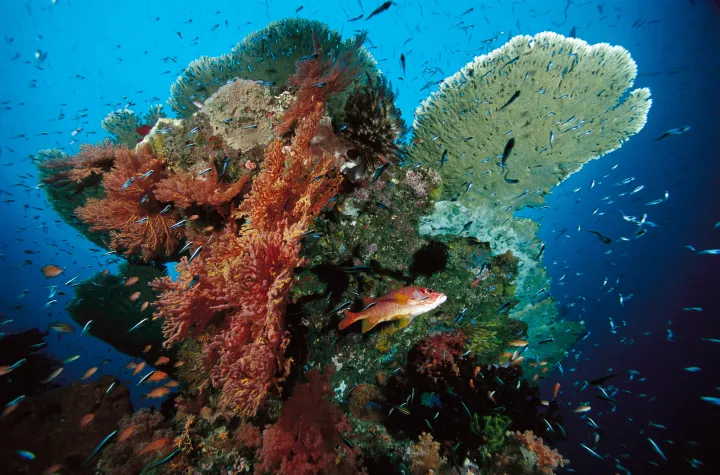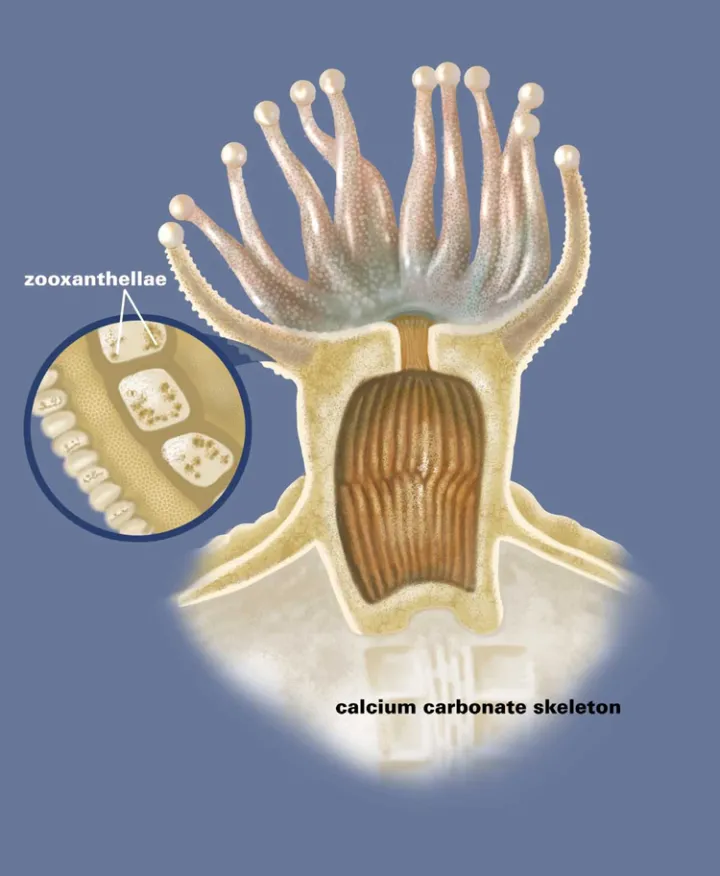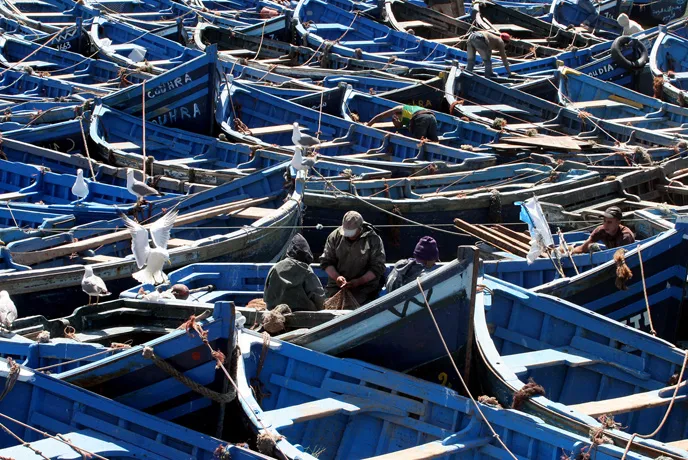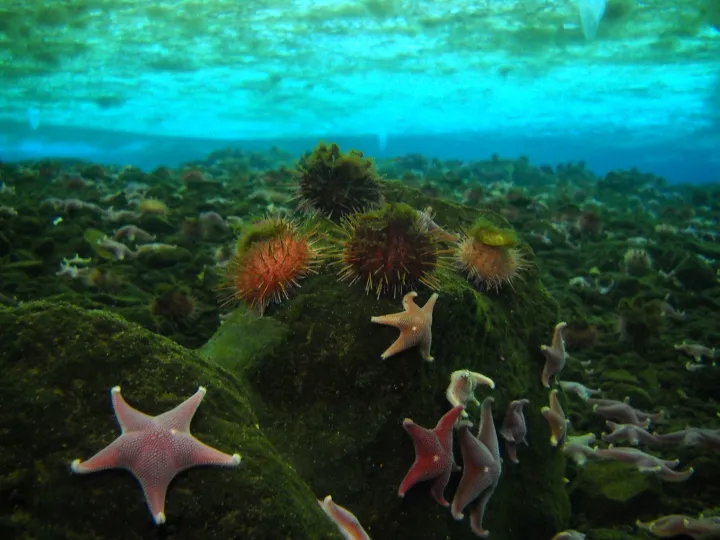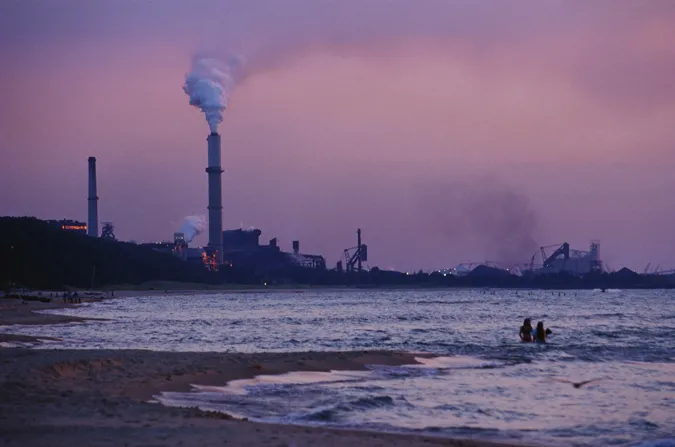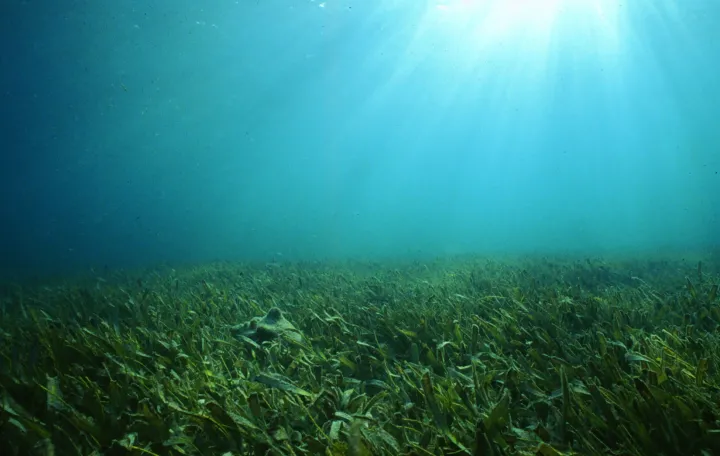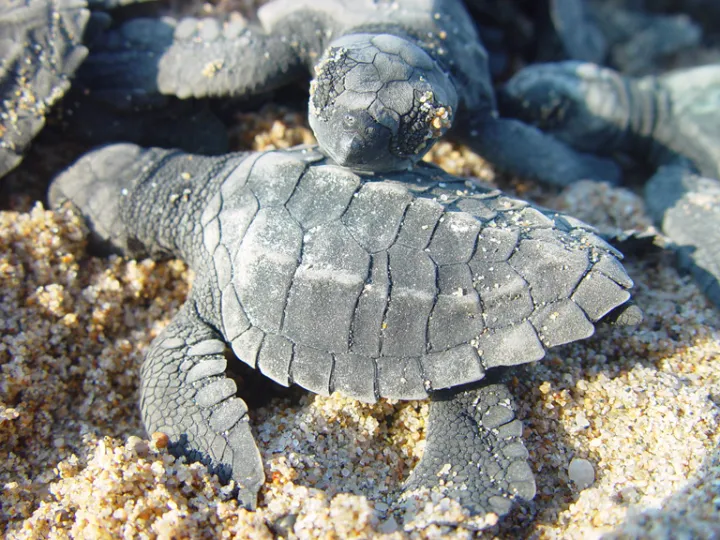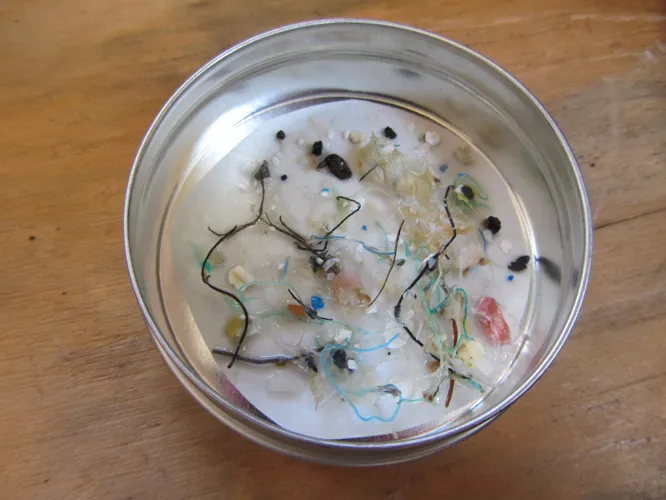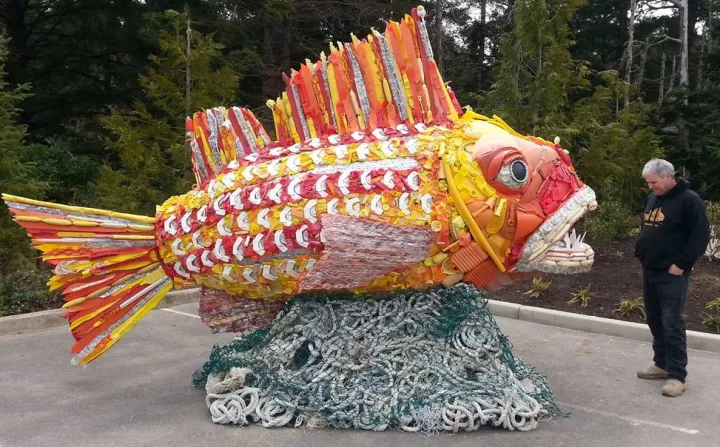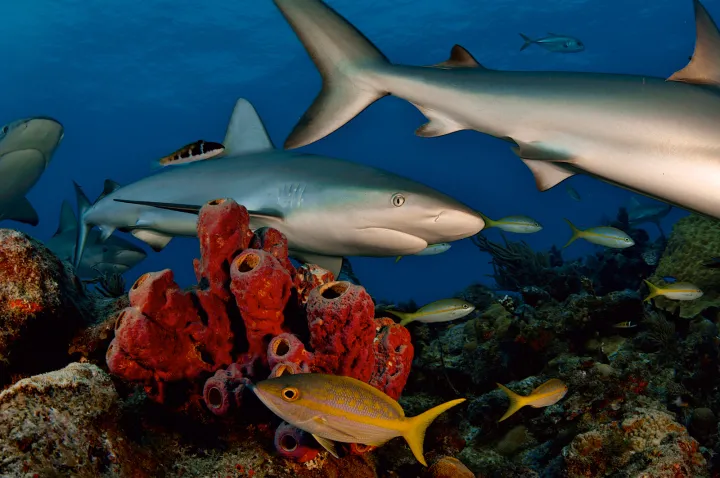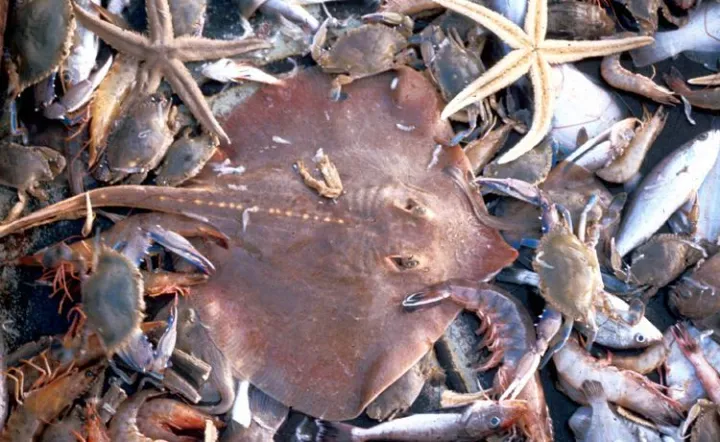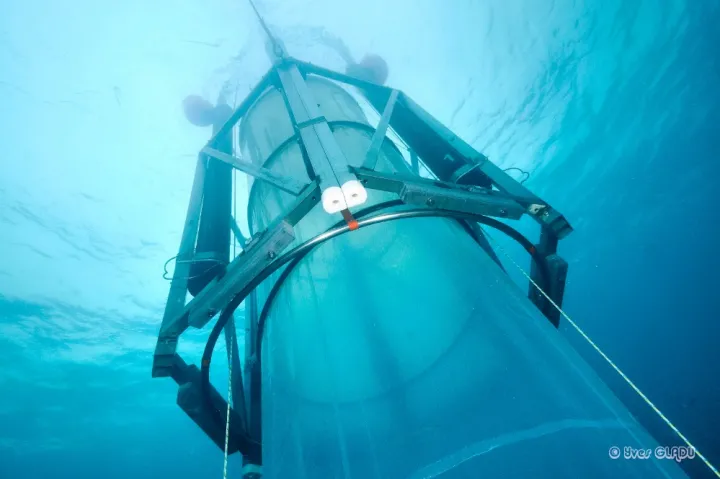
American Spaces
Introduction
Welcome to the Ocean Portal & American Spaces activity page!
This curriculum on ocean science and conservation was designed for the U.S. Department of State’s American Spaces program, although it can be used by anyone. There are more than 700 American Spaces in embassies, schools, libraries, and other partner institutions in 169 countries, attracting approximately 16 million visitors each year. They provide programming and information about United States' policies, culture, and values as well as exchange and study opportunities in the United States. They also support English language learning and activities for alumni of international visitor programs. To learn more about American Spaces, you can visit the U.S. Department of State’s website.
These activities will allow facilitators in those spaces to teach about or lead discussions on ocean science and conservation using materials from the Smithsonian Institution and elsewhere. If you are a facilitator please see the "Facilitator Resources" section on the left, where you can find answer keys, printable PDF versions (indicated by ![]() ) and more information about each activity.
) and more information about each activity.
Ocean Introduction
For those of us who can't see the ocean from our windows, it's easy to forget the critical role the ocean plays in human life. The salty water of the ocean covers more than 70 percent of the Earth's surface. Ocean plants produce about 50 percent of the planet's oxygen. Seawater absorbs a third of the carbon dioxide we pump into the atmosphere. And right in your kitchen, seaweed extract helps keeps your peanut butter and ice cream creamy! So even though the ocean may be far away for some, the health of the ocean affects us all, and we all have a role to play in caring for it.
Activity 1: Intro Discussion
Explore the ‘Your Ocean’ map on the Ocean Portal as a group or break out into small groups. If you don't have an internet connection, look at the ocean on a map and look at photos of ocean life from books.
DISCUSSION QUESTIONS:
Is the ocean the same everywhere?
What are some differences you expect to see between different ocean regions?
What qualities do you expect have the greatest influence on ocean ecosystems in different areas?
What connects you to the ocean?
Have you ever been to the ocean? How did it make you feel? What was your favorite part?
Activity 2: Reading Comprehension
Read about life on Planet Ocean on the Q?rius website. ![]() Students should write down answers and then go over the following questions as a group. (Student worksheet:
Students should write down answers and then go over the following questions as a group. (Student worksheet: ![]() )
)
1. How deep is the deepest valley found in the ocean?
2. Where does more than 25 percent of marine life live in the ocean?
3. How much of the oxygen in the air we breathe is from the ocean? What makes the oxygen?
4. What types of ecosystems can protect coastlines from storms?
Activity 3: Beach, Stream or Trail Cleanup
Whether you live near the ocean or in the middle of a large city, your actions are connected to the ocean. We rely on the ocean for oxygen, food and weather regulation among many other things. We also can impact the ocean with our use of fossil fuels (like gas, coal, oil), which have byproducts (like carbon dioxide) that increase its temperature and acidity. And trash dumped anywhere—whether on the beach or on the side of the road hundreds of miles inland—usually ends up in our waterways.
Locate a beach, stream or street where you can safely remove accumulated trash and use this as a starting point for discussing how trash can end up in the ocean.
MATERIALS NEEDED:
Work gloves
Trash collection containers (reusable bucket, plastic milk jug with the top cut off, reused plastic shopping bags)
As containers are filled, dump them into a central collection site, such as a dumpster, trash can, or large trash bag.
Note: Future lessons use collected trash for art projects; wash and save your collection if you intend to do these activities!
DISCUSSION QUESTIONS:
How does trash get to the ocean from far away?
Do certain kinds of trash travel faster than others?
Why is trash in the ocean a problem?
Activity 4: Explore A Success Story
Read the article “Cabo Pulmo—Giving Optimism to Coral Reefs” individually or out loud from the website (or print out the PDF version ![]() ). Discuss the following as a group:
). Discuss the following as a group:
- How can marine protected areas help ecosystems recover when so many ocean animals can swim in and out of the protected space?
- How does enforcement play a part in the success of efforts to protect marine species and ecosystems?
- How do scientists measure success of a marine protected area? Does counting biomass make the most sense to you?
Activity 5: Waters of the Earth
Earth as seen from space is clearly a water planet. About 70 percent of the surface of the planet is covered by water. Water is found in the ocean, rivers, ponds, lakes, groundwater, ice caps, glaciers, and in the atmosphere as water vapor and clouds. Water changes state and moves from place to place through the water cycle of evaporation, condensation, and precipitation. Although Earth's water supplies seem almost limitless when viewed from an ocean beach, water forms only a thin film on the surface of the planet. The average depth of the oceans is about 3.5 - 4.0 km, while the average radius of earth is 6,371 km.
What to Expect: Some of these volumes are so small that the class will need to gather around the display to see the water being added. The clear bottles with blue colored water in them, clearly labeled, make a dramatic display for the school or community.
Activity 6: Review
Group discussion to summarize the lesson
- Why is the ocean important?
- How are humans linked to the ocean, even if they don’t live near it?
- What are some ways we can help the ocean?
Background & Media
5 Simple Things You Can Do For The Ocean
What’s Working When It Comes To The Ocean?
Warming, Rising Acidity and Pollution: Top Threats to the Ocean
Additional Activities
Corals & Coral Reefs
Coral reefs are the most diverse of all marine ecosystems. They teem with life, with perhaps one quarter of all ocean species depending on reefs for food and shelter. Because they are so diverse, coral reefs are often called the rainforests of the sea. Coral reefs are also very important to people, providing food, protection of shorelines, jobs based on tourism, and even medicines.
Activity 1: Introduction to Coral Reefs
As a group, look through the Bizarre and Beautiful Coral Reef Animals slideshow ![]() . Show the photos on a projector or on individual computer monitors (or, if you have no computer access, print off the PDF version of the slideshow), and read some of the captions aloud. This part of the lesson is to get a sense of the diversity of life that lives on a coral reef, and what a healthy coral reef looks like. Talk about the variety of animals portrayed—different kinds (fish, slugs, turtles, crabs, etc.) and different sizes (very tiny to very big).
. Show the photos on a projector or on individual computer monitors (or, if you have no computer access, print off the PDF version of the slideshow), and read some of the captions aloud. This part of the lesson is to get a sense of the diversity of life that lives on a coral reef, and what a healthy coral reef looks like. Talk about the variety of animals portrayed—different kinds (fish, slugs, turtles, crabs, etc.) and different sizes (very tiny to very big).
Talk through discussion questions as a group:
- What was your favorite animal and why?
- Did you notice coral in the pictures? Where?
Activity 2: Reading Comprehension
Read as far as you can through the Corals and Coral Reefs topic page. ![]() Students should write down answers and then go over the following questions as a group. (Student worksheet:
Students should write down answers and then go over the following questions as a group. (Student worksheet: ![]() )
)
1. Are corals animals, vegetables, or minerals?
2. Label the parts of a coral on the diagram to the right.
3. What is the difference between a coral animal and a coral reef?
4. Where are coral reefs found?
5. How do coral reefs help people?
6. List three threats to coral reefs.
7. What can you do to protect coral reefs?
VOCABULARY SCAVENGER HUNT:
1. Define "polyp"
2. Define "coral bleaching."
3. Define “sexual reproduction” and “asexual reproduction.” What is the difference?
Activity 3: Hands-on Reefs Unleashed
Go to the Smithsonian Q?rius site. (There is no offline version of the activity).
Watch Smithsonian marine biologist Nancy Knowlton explain how and why she and her colleagues document the diversity of life in our planet's ocean.
Complete the identification challenge, finding life from plastic pieces left in the ocean. Then move on to compare the different species and uncover their DNA secrets.
Activity 4: Explore A Success Story
Read the blog “The Reefs of American Samoa: A Story of Hope” (or print off PDF version ![]() ). Discuss the following as a group:
). Discuss the following as a group:
- What are some threats to coral reefs in American Samoa?
- Why are reefs so important to Samoans?
- What are some of the impacts of runoff on coral reefs?
- How do you work to improve an ecosystem with so many various potential stressors?
Activity 5: How Do Coral Reefs Form?
Coral reefs provide a variety of habitats, each with its own set of characteristic species. Different species of coral come in different shapes and forms. These activities will give students an understanding of how coral reefs are formed. Starting from a single “polyp” to a coral with skeleton attached, and finally to a coral reef. Students will identify three different types of corals most commonly found in American Samoa and understand their growth by applying hands-on activities.
OBJECTIVES
Students will be able to:
1. Explain how coral reefs are formed.
2. Identify three shapes of corals.
3. Name three threats to coral reefs.
Continue with full lesson plan from National Park of American Samoa. ![]()
Activity 6: Review
Group discussion to summarize the lesson
- Discuss the diversity found on coral reefs.
- What is a coral? How does it relate to a coral reef?
- How do other animals rely on coral reefs?
Background & Media
Video about connecting coral reef protected areas
Article about Australia’s Great Barrier Reef
Slideshow showing two views of coral reefs
Article on recovery of bleached Panamanian coral
Article on boring sponges and their relationship to coral
Article on marine protected areas and coral reefs
Additional activities
Overfishing
Many human cultures from around the world have a deep connection to the ocean, and 3 billion people rely on fisheries for 20 percent of their protein. The ocean may seem like it can provide an endless amount of fish, but the fact is that fish can’t reproduce fast enough to keep up with modern fishing practices, particularly when combined with other threats to the ocean such as warming waters, pollution and ocean acidification. Many fish populations around the world are facing collapse due to large-scale trawling and other types of commercial fishing. We have many challenges ahead to conserve the sea's biodiversity, resources, and value to human culture and society, but also many possibilities available right now to meet these challenges.
Activity 1: Introduction to Overfishing
As a group, look through the world fisheries slideshow ![]() . Show the photos on a projector or on individual computer monitors (or, if you have no computer access, print off the PDF version of the slideshow), and read some of the captions aloud. This part of the lesson will help to familiarize students with fisheries around the world.
. Show the photos on a projector or on individual computer monitors (or, if you have no computer access, print off the PDF version of the slideshow), and read some of the captions aloud. This part of the lesson will help to familiarize students with fisheries around the world.
If you have time take a look at the Sustainable Seafood overview ![]() and talk through some of the ways that humans are using technology to support fisheries and some solutions to the overfishing problem.
and talk through some of the ways that humans are using technology to support fisheries and some solutions to the overfishing problem.
Talk through discussion questions as a group:
- What are some of the various ways that fish are caught?
- What is bycatch?
- What food from the sea do you eat? Do you know how it is caught?
Activity 2: Reading Comprehension
Read through the Helpful Herbivores article ![]() aloud as a group or have students read individually. Students should write down answers and then go over the following questions as a group. (Student worksheet:
aloud as a group or have students read individually. Students should write down answers and then go over the following questions as a group. (Student worksheet:![]() )
)
1. How does seaweed harm coral?
2. What kind of fish are important to protecting corals from seaweed and why?
3. What causes seaweed to grow out of control on coral reefs?
4. What is resilience and how does it help coral reefs?
5. How can marine protected areas help stop seaweed growth?
VOCABULARY SCAVENGER HUNT:
1. Define "ecological resilience"
2. Define "herbivorous"
3. Define “marine protected area”
Activity 3: Fishing for the Future
Through a fishing simulation, students model several consecutive seasons of a commercial fishery and explore how technology, population growth, and sustainable practices impact fish catch and fisheries management. (Intended for grades 6-12)
OBJECTIVES:
Students will:
- Experience the “tragedy of the commons” as it relates to fishing resources. (The “tragedy of the commons” occurs when resources—such as the water we drink, and the fish we eat—shared by everyone (or held in common) are used at a rate that exceeds the resources’ sustainable limit. Ultimately, as population grows and consumption increases, the “commons” collapse. The phrase was first coined by Garrett Hardin in 1968.)
- Consider social, environmental, and economic impacts of overfishing.
- Identify sustainable fishing practices.
Continue with full lesson plan from WETA/PBS Marine Fisheries and Aquaculture Series.
Activity 4: Review
Group discussion to summarize the lesson
- What are some types of modern fishing and what species are caught?
- Can fish be caught with no regulations?
- What are some ways that fishing can be sustainable?
Background & Media
Video from PBS about overfishing around the world
Sustainable Seafood Glossary of Terms
Additional activities
Marine Fisheries Collapse Simulation
Catch, Tag and Release (PDF)
The Poles
We often think of the poles together, but life and the physical characteristics of the Arctic Ocean and Southern Ocean are vastly different. The Arctic Ocean covers the North Pole and is mostly surrounded by land from northern Canada, Russia and Greenland. It's also relatively calm because it’s largely covered by ice. Polar bears and walruses roam about. The Southern Ocean, with no surrounding land as protection, is more turbulent. It supports penguins and a large number of distinctive species because it has been isolated for 30 million years.
Activity 1: Introduction to the Poles
Visit the Antarctic and Arctic as a group by reviewing two slideshows: one that takes you to the Arctic ![]() and one to the Ross Sea in Antarctica.
and one to the Ross Sea in Antarctica. ![]() Show the photos on a projector or on individual computer monitors (or, if you have no computer access, print off the PDF version of the slideshow), and read some of the captions aloud. This part of the lesson will help to familiarize students with the two Poles and help them get a sense of the differences and similarities.
Show the photos on a projector or on individual computer monitors (or, if you have no computer access, print off the PDF version of the slideshow), and read some of the captions aloud. This part of the lesson will help to familiarize students with the two Poles and help them get a sense of the differences and similarities.
Watch a video highlighting the various kinds of sea ice.
Talk through discussion questions as a group:
- What are some similarities between the Arctic and Antarctic? Some differences?
- What are some of the different forms of sea ice?
Activity 2: Reading Comprehension
Read through the Poles overview (online or from a printout of the PDF) as a group or have students read individually. Students should write down answers and then go over the following questions as a group. (Student worksheet: ![]() )
)
1. What forms the basis of the food web in the Arctic Ocean?
2. What isolates Antarctica from the other continents?
3. How do penguins in Antarctica handle the freezing temperatures?
4. How many species can be found in both the Arctic and Antarctic? What are some of these species?
5. What is sea ice? What are the different kinds of sea ice?
6. How are the poles changing?
VOCABULARY SCAVENGER HUNT
1. Define “glacial ice”
2. Define “indigenous”
3. Define “hemoglobin”
4. Define “fast ice”
Activity 3: Three Ice Realms
Through reading comprehension and discussion students will learn about the different layers of the polar Arctic Ocean: pelagic, benthic and sea ice.
The Arctic Ocean is the most inaccessible and least-studied of all the Earth’s major oceans. Although it is the smallest of the world’s four oceans, the Arctic Ocean has a total area of about 14 million square kilometers (5.4 million square miles) or roughly 1.5 times the size of the United States. Its communities can be divided into three main groups: the sea-ice realm, the pelagic realm and the benthic realm.
Learning Objectives:
- Students will be able to compare and contrast the pelagic, benthic and sea ice realms of the Arctic Ocean.
- Students will be able to name at least three organisms that are typical of each of these three realms.
- Students will be able to explain how the pelagic, benthic and sea ice realms interact with each other.
Continue with the full lesson plan from NOAA Ocean Explorer. ![]()
Activity 4: Review
Group discussion to summarize the lesson
- What are some differences and similarities between the Arctic and Antarctic?
- What are some animals found in the Arctic and Antarctic? How do they adapt to the cold environment?
- How will climate change impact the polar regions?
Background & Media
Video of receding ice cover in the Arctic over time
Ice-loving Seals and the Loss of Sea Ice
The Sant Ocean Hall, Life at the Poles Exhibit
Archaeologists Study Early Whaling Community in Quebec, Canada
Additional activities
Climate Change
With over seven billion people, the impact of our collective actions on planet Earth is huge. Coal, oil and natural gas (all fossil fuels that produce carbon dioxide when burned) fuel almost everything that we do: driving cars, flying in planes, and using electricity to power our lights and our electronics and heat and cool our buildings. When carbon dioxide and other “greenhouse” gases are released into the atmosphere, they trap the heat from the sun and warm the entire planet, both the atmosphere and the ocean. The consequences of this warming are far-flung and not totally understood, but include changes in weather patterns, rising seas, and much more. Carbon dioxide also dissolves into the ocean, making it more acidic. Many of these impacts will be long-lasting as carbon dioxide stays in the atmosphere for centuries.
The situation is not hopeless, however, and people are increasingly aware that we need to do something in order to prevent catastrophic changes. There are ways that humans can change in order to release less carbon dioxide into the atmosphere, including making use of renewable energy sources like the wind and the sun. Other actions can reduce the harm that is done by climate change.
Activity 1: Introduction to Climate Change
As a group, watch this video explanation of climate change and discuss the following questions:
- Where does carbon dioxide come from?
- Where does carbon dioxide get absorbed?
- What are some things you do that use fossil fuels?
- Talk about the impacts that increased carbon dioxide in our atmosphere may have
Activity 2: Reading Comprehension
Read as far as you can through the Climate Change topic page (or print out the PDF ![]() ) and use it to answer the following questions. (Student worksheet:
) and use it to answer the following questions. (Student worksheet: ![]() )
)
1. Why are carbon dioxide levels higher than they've been in 15 million years?
2. How do scientists know about the Earth’s past climate and carbon dioxide (CO2) levels?
3. What is a consequence of carbon dioxide dissolving into seawater?
4. Why will climate change cause the sea level to rise?
5. What are some of the ripple effects of climate change on animals and ecosystems?
VOCABULARY SCAVENGER HUNT:
1. Define “greenhouse effect”
2. Define "foraminifera"
Activity 3: Global Climate Change and Sea Level Rise
Global climate change is becoming a threat to our current way of life on Earth. One consequence of climate change is the melting of ice caps, glaciers, and sea ice, including polar ice in Greenland and Antarctica. Substantial melt of these massive glaciers will cause a rise in sea level along coastlines throughout the globe.
This activity will explore how melting ice impacts sea level. Ice already in the oceans does not contribute to sea level rise, but ice on land will contribute to sea level rise upon melting. Greenland, for example, is covered by vast quantities of ice. The melting of this ice will contribute to sea level rise. In contrast, the sea ice in the area of the North Pole is floating in water and thus the melting of this ice will not contribute to sea level rise.
Objectives
In this lesson, students will:
1. Learn that ice formations on land will cause a rise in sea level when they melt, whereas ice formations on water will not cause a rise in sea level when they melt.
2. Learn that ice is less dense than water.
3. Learn that ice displaces water equal to the mass of the ice.
4. Practice some of the steps involved in a science investigation.
Cotinue with the full lesson plan from the California Academy of Sciences.
Activity 4: Review
Group discussion to summarize the lesson
- What is the mechanism causing climate change?
- How do we know climate change is caused by humans?
- How can humans help to slow down the impacts of climate change?
Background & Media
Video on climate change impacts on glaciers and ice sheets
Foraminifer on the Seafloor [Video]
Why Melting Glaciers Matter to the Coasts [Video from The National Park Service]
Warming, Rising Acidity and Pollution: Top Threats to the Ocean
Additional activities
Social, economic and environmental consequences of arctic climate change
Coastal Ecosystems
At the border between land and sea, coastal ecosystems like salt marshes, mangroves and seagrass beds are where people and the ocean interact most. Along the coast, land plants evolved to survive salt water. With their fast growth rates, these plants are an important food source for the many adult and juvenile animals that live among them. Marsh and seagrass blades and mangrove roots provide structure and habitat for organisms to grow upon and hide behind, and for this reason they are important nurseries for fish we like to eat. And once they die, the plant matter is broken down and eaten by another set of organisms, many of them microscopic. These ecosystems also take carbon dioxide from the atmosphere, helping to reduce global warming and ocean acidification.
But many coastal ecosystems are under threat. As people develop coastal areas, nutrients from fertilizers are carried by runoff into these complex ecosystems. The nutrients stimulate the growth of microbes that cover the leaves and make the water cloudy, reducing the light that the seagrasses need to survive. Paved roads and poor construction practices allow more sediment and dirt from land to flow into the water, blocking sunlight the plants need to survive. In salt marshes, many of the plants are being replaced by aggressive invasive species from around of the world, which support fewer kinds of animal life. Many mangrove forests have been cut down to make way for aquaculture ponds or buildings. In many places, however, people are beginning to realize the need for regulations to protect these coastal ecosystems from destruction.
Activity 1: Introduction to Coastal Ecosystems
Mangrove ecosystems are based around mangrove trees, which have adapted to salt water and support life in and out of the ocean.
Look through the slideshow of species that live in mangrove forests, above and below water (or use the PDF version ![]() ).
).
Spend some time looking at the second slide of mangrove roots underwater. How many species can the students count?
Read some of the descriptions aloud, to give a sense of the diversity of life on mangroves.
Discussion questions:
- Had any students heard of or seen mangroves before?
- Were there more kinds of species than they expected?
- What did they learn from the photos?
Then, watch this short video about Smithsonian researcher Dr. Candy Feller.
Discussion questions:
- How do mangroves help people?
- What is runoff?
- How do nutrients hurt mangroves?
Activity 2: Reading Comprehension
Read about seagrasses and seagrass beds on our overview page (or use the PDF version ![]() ). Students should write down answers and then go over the following questions as a group. (Student worksheet:
). Students should write down answers and then go over the following questions as a group. (Student worksheet: ![]() )
)
1. Where are seagrasses and seagrass beds found?
2. How do seagrasses reproduce?
3. Seagrass beds can support thousands of species. Briefly describe three ways that they support this diverse food web.
4. Why is seagrass known as the “lungs of the sea?”
5. What is the main culprit that has killed off 29 percent of the world’s seagrass beds in the past century?
6. What is one way to protect and restore seagrass beds?
7. Name two ways that mangrove forests and seagrass beds are similar, and one way that they are different.
VOCABULARY SCAVENGER HUNT:
1. Define “rhizome root system”
2. Define “blue carbon”
3. What is “killer algae?”
Activity 3: Oil's Impact on Black Mangrove Trees
The health of mangrove ecosystems is directly connected to the health of other ocean ecosystems. Mangrove trees build new islands, stabilize sediment, prevent erosion, and reduce wave action. The roots provide habitat and serve as nursery grounds for many species of marine organisms, some of which filter the water and keep it clear. When oil enters into mangrove environments, it clogs the breathing pores located on the snorkel roots of black mangrove trees. These trees then suffocate and die. Keeping oil out of mangrove ecosystems is essential to the health of the ocean.
In this activity, students will build a model of black mangrove roots out of straws. After testing how the roots continue to “breathe” above water, they will add oil to their ecosystem to see how that affects the roots.
OBJECTIVES:
- explain how mangrove trees take in air in an anoxic environment (one with little or now oxygen)
- describe some of the short-term effects of oil entering into a mangrove environment and hypothesize about long-term effects
Continue the full lesson plan from National Geographic.
Activity 4: Wrap-up Discussion
Group discussion to summarize the lesson:
1. Describe two kinds of coastal ecosystems.
2. Explain how coastal ecosystems are important to ocean health.
3. Describe two threats to coastal ecosystems.
Background and Media:
Slideshow of Mangrove plants and animals
Additional Activities:
Sea Turtles
There are seven species of sea turtles, which are marine reptiles that need to breathe air to survive. Six of the seven species are found in US and other waters, while the flatback turtle is only found in the Indian Ocean and western Pacific Ocean near Australia and Indonesia. Most of their lives are spent at sea, with some species diving to depths of 900 meters (3000 feet). They return to the shore to lay eggs, often making long journeys to go to specific beaches year after year.
Currently all six of the species found in US waters are listed as endangered under the Endangered Species Act, and those six are also found on the IUCN Red List, where their listings range from Vulnerable to Critically Endangered. Human activities pose a number of threats to sea turtles. The animals can become entangled in fishing gear, or wrapped up in marine debris. They often mistake pieces of plastic trash for food, causing illness or death. Coastal habitat destruction can impact their nesting grounds that they return to year after year. Poaching of adults and eggs continues to be an issue and the warming sea impacts their typical cues for coming to shore and laying eggs.
Activity 1: Introduction to Sea Turtles
Watch this video about a sea turtle hospital from National Geographic:
Discussion questions:
- What are some of the big threats to sea turtles?
- Why do you think sea turtles are particularly vulnerable to human threats?
- Why is saving even one sea turtle important to their species' survival?
Activity 2: Reading Comprehension
1. How deep can turtles dive?
2. List three threats that sea turtles face.
3. What do green sea turtles eat?
4. What makes the leatherback sea turtle different from other sea turtle species?
VOCABULARY SCAVENGER HUNT:
1. Define "carapace"
2. Define "arribada”
Activity 3: Climate Change and Sea Turtles
Discuss the concept of climate change with your students. (If you've already completed the American Spaces Climate Change Lesson, do a quick review and move on to turtles.) What is climate change? How could it affect our lives? How might it affect the lives of wild animals? Would it affect sea turtles? How?
Objective
Students will be able to describe how turtle populations may be affected by climate change and develop a solution to the problems turtles could face as a result of climate change.
Continue to the full lesson plan from Jean-Michel Cousteau Ocean Adventures.
Activity 4: Review
Group discussion to summarize the lesson
- What are the seven species of sea turtles?
- How do humans impact sea turtles?
- How specifically does climate change impact sea turtles?
Background & Media
Loggerhead turtle escapes from fishing net
Tagging and Tracking Ocean Animals
Additional activities
Pollution
Ocean pollution can take many forms: oils spills, sewage and agricultural runoff, trash dumping and small bits of plastic are just a few types. Many of the items we purchase and consume everyday are packaged in plastic that is then quickly thrown away. Only a small percentage of that plastic is recycled. Even trash that starts on land ends up in the ocean as it moves through rivers, drains and watersheds to the sea. It is not clear how many tons of plastic wind up in the ocean every year, but one researcher estimates that there are over 300 billion pounds (136 billion kgs) of plastic in the ocean (that is 42 lbs or 19 kgs of plastic for every human on the planet!).
Not only does trash wash up on our shores and beaches, but once in the ocean, larger plastic pieces are broken down into smaller and smaller pieces. These small pieces are perfectly sized for fish and other animals to mistakenly eat since it looks like their next meal. Ingesting or getting tangled in plastic can kill these important ocean animals. Ocean waves and currents move the plastic and other trash to central ocean gyres (ring-like systems of ocean currents), where they are trapped on or near the surface in the middle of the oceans in areas referred to as “garbage patches”. This pollution problem is one that we can solve. Think about what you can do to reduce the amount of plastic you throw away.
Activity 1: Ocean Pollution Introduction
As a group watch the video and read the blog Witness to a Plastic Invasion. ![]()
Discussion questions:
- At the start of the video, what did you think was floating at the surface?
- When did you realize what it was?
- How did that make you feel?
- What do you use in your everyday life that is made of plastic and discarded? Did you see any of those items in the video?
- What can you do to reduce your use of plastic?
Activity 2: Reading Comprehension
Read about ocean pollution and stories of successfully removing plastic from the ocean ![]() . Students should write down answers and then go over the following questions as a group. (Student worksheet:
. Students should write down answers and then go over the following questions as a group. (Student worksheet: ![]() )
)
1. How can even small pieces of plastic harm the ocean and animals in the ocean?
2. How much trash did volunteers with the International Coastal Cleanup in 2013 collect? What was the most common item of trash?
3. What are discarded nets in the ocean being turned into? How is this helpful?
4. How much did plastic bag consumption drop in Ireland after implementing a bag tax?
VOCABULARY SCAVENGER HUNT:
1. Define “ghost nets”
2. What is a “bag tax”
Activity 3: Does it sink or swim?
Marine debris is trash that is found in or by the sea. Any object foreign to the marine ecosystem can be considered marine debris, but the term is usually reserved for human-created trash. Two major factors that affect if an item will enter the marine environment are buoyancy and the ability to be blown by the wind. As a rule of thumb, if the item can fly and float it is more likely to enter the marine environment and end up on our beaches. Plastics readily fly and float, and decompose very slowly. Not surprisingly, plastics are one of the most frequently collected types of marine debris.
Students will perform experiments to examine if debris will float, or blow in the wind. The effects of these characteristics on the marine debris are then discussed.
OBJECTIVES:
Students will be able to:
- Define marine debris.
- Categorize different types of debris.
- Determine how a material can influence what becomes marine debris.
Continue the full lesson plan from the Bishop Museum.
Activity 4: Turning Trash Into Treasure
Together, or in small groups, read through and look at pictures about the organization Washed Ashore. ![]()
Washed Ashore turns recycled ocean trash into beautiful sculptures. Conduct a beach/stream cleanup (see 'Ocean Introduction' for activity), or use the same materials from previous activity. Clean the plastic trash found during the cleanup in soapy water, discard any dangerous items, and distribute with paper and glue to create your own Washed Ashore art.
Activity 5: Review
Group discussion to summarize the lesson
- What are different kinds of ocean pollution?
- What is an ocean gyre and how does it relate to plastic pollution?
- What can you do to help reduce or clean up plastic pollution?
Background & Media
5 Gyres: Understanding Plastic Pollution Through Exploration, Education and Action
Laysan Albatrosses’ Plastic Problem (slideshow)
Cleaning up beaches in Bonaire
Additional activities
Decorate reusable bags for shopping
Different types of marine debris (PDF)
Estuaries and oil spills (PDF)
Sharks
Sharks and their relatives, the rays, are cartilaginous fish—their skeletons (like our noses and ears) are made of cartilage rather than bone. There are more than 500 species of sharks swimming in the world’s ocean. They range in size from the length of a human hand to more than 39 feet (12 meters) long, and are found in just about every kind of ocean habitat, including the deep sea, open ocean, coral reefs, and under the Arctic ice.
Yet when most people think of sharks, a single image comes to mind: a large, sharp-toothed and scary beast. That generalization downplays their variety, their important role in keeping ocean ecosystems in balance, and the trouble sharks are in around the world. An estimated 100 million sharks are killed by fisheries every year, largely to make soup out of their fins. Sharks reproduce very slowly, and these actions have decreased many shark populations by 90 percent since large-scale fishing began. To protect them, communities and companies around the world are enacting science-based fisheries management policies, setting up shark sanctuaries, and banning the practice of shark finning and the trade of shark fins.
Activity 1: Intro Discussion
Start off with some basic discussion questions for the whole group. Write down student responses on the board, a big piece of paper, or have a student be a scribe.
1. When you think of sharks, what is the first thing that comes to mind?
2. Challenge responses that think about sharks stereotypically.
- Did lots of words for great whites or other big predatory sharks come up? Tell the students that there are more than 500 species of shark, and half of them are less than 1 meter (3 feet) long. Only about 12 shark species are potentially dangerous to humans.
- Are there lots of fear words, like "shark attack," "scary," "killer," etc? Remind them that, on average, only four people in the world are killed every year by sharks. Ask for examples of activities that kill more than four people worldwide every year, such as drowning, dog bites, lightning strikes, car accidents, bike accidents.
Next, provide some inspiration to add to the list of words describing sharks. As a group, look through the Spectacular Shark Pictures slideshow. Show the photos on a projector or on individual computer monitors (or, if you have no computer access, print off the PDF version of the slideshow ![]() ), and read some of the captions aloud. As you go, ask students to add new words and phrases to the list to expand your crowd-sourced definition for sharks. Anything goes here: qualitative descriptions like "beautiful" or "graceful" or "small," as well as facts like "unique rough skin" or "threatened by people."
), and read some of the captions aloud. As you go, ask students to add new words and phrases to the list to expand your crowd-sourced definition for sharks. Anything goes here: qualitative descriptions like "beautiful" or "graceful" or "small," as well as facts like "unique rough skin" or "threatened by people."
Then wrap it up: how did the words change? Did it change the students' opinions of sharks?
Activity 2: Reading Comprehension
Read as far as you can through the Sharks topic page (PDF version ![]() ) and use it to answer the following questions. Students should write down answers and then go over the following questions as a group. (Student worksheet:
) and use it to answer the following questions. Students should write down answers and then go over the following questions as a group. (Student worksheet: ![]() )
)
1. Name two defining characteristics of sharks.
2. Describe three species or groups of sharks you had never heard of before this class. If you can, draw a picture.
3. List the hunting and feeding adaptations of two sharks.
4. List two threats to sharks.
5. Name two ways countries and companies are protecting sharks.
6. Have any laws been passed in your country? [Check out the country list in the video at the bottom of the page, or look it up online.]
VOCABULARY SCAVENGER HUNT:
1. Define "denticles"
2. Define "shark finning"
Activity 3: Video: What If There Were No Sharks?
Let's learn a bit more about what how sharks help their ecosystems.
Discussion questions:
1. What would happen if there were no sharks?
2. In the video, the host Joe Hansen says that in Palau, a shark is worth $2 million alive because of tourism (see footage at 2 min 42 sec). How could a living shark be worth that much money?
Activity 4: Shark Design Challenge
The California coast and the Hawaiian islands are among the most popular surfing locations in the world. They are also renowned for another reason: predator sharks. The great white shark preys on elephant seals and sea lions along the California coast, while the tiger shark targets albatross, monk seals, and green sea turtles in the Hawaiian islands. When sharks move into one of these coastal areas to feed, they sometimes attack people surfing in the same waters. Do sharks seek out human prey, or do they mistake humans for their usual food sources? How have changes in the population of some prey affected the frequency of shark attacks on humans in certain locations? Does hunting and killing sharks after an attack prevent further attacks? Marine biologists in this program try to answer these questions.
OBJECTIVE:
To design a solution to help surfers avoid being attacked by sharks.
Continue to the full lesson plan from PBS.
Activity 5: Review
Group discussion to summarize the lesson:
- What are some shark species you learned about today that you'd never heard of before? Name them and give a fact about them
- What would happen if all sharks went extinct? How would that affect people that live near the ocean and people that live far away?
- What human activities threaten sharks?
- What can you do to help sharks?
Background & Media
Shark finning: Sharks turned prey
Short video about how a scientist is using DNA to catch shark poachers
Great white shark overview article
Blog post about what it's like to go swimming with sharks
Podcast about the slow-moving Arctic Greenland shark
X-rays of sharks and rays show their cartilaginous skeletons
Changing shark fear to fascination, an essay by teenage shark filmmaker Madison Stewart
Video about the harm done to sharks by shark nets installed at beaches
Relative risks of shark attack
Additional Activities:
Bycatch
When people go out fishing, they are often looking for a specific kind of fish or sea animal—but it's nearly impossible to catch just what you're looking for. Pulling a net through the water catches all the animals in its path, not just the tasty fish. Baited hooks attract seabirds, sharks and other animals along with the big tuna or swordfish that are being sought.
All the animals that are caught unintentionally and by accident are called bycatch, and it's widely considered a big waste of ocean resources and animal life. Some animals are able to survive being caught in a net and thrown back overboard, but many others aren't.
Activity 1: Intro Discussion
As a group, look through the Bycatch slideshow (or print the PDF version ![]() ). (This isn't necessarily going to be easy: lots of images of dead animals caught in nets.) Describe the images and how they make them feel. Why does this happen? Why is it a bad thing? Should something be done about it?
). (This isn't necessarily going to be easy: lots of images of dead animals caught in nets.) Describe the images and how they make them feel. Why does this happen? Why is it a bad thing? Should something be done about it?
Then define bycatch: when fishing gear unintentionally catches animals unwanted by the fisherwoman/man. Sometimes these animals can be thrown back alive and survive, but other times it hurts them, changes their behavior, or kills them. The FAO estimates that 7.3 million tons of unwanted sea creatures are thrown away every year; NOAA estimates that 1 ton of bycatch is thrown out for every 4 tons of target fish caught.
DISCUSSION QUESTIONS:
- Why would fishermen only want to catch certain fish?
- Do you know of any specific fisheries that are known for bycatch?
- Reference the photos to talk about some common types of bycatch, such as turtles, sharks, seabirds, whales, and dolphins. Why do you think these animals are often killed when caught in nets?
- What are the impacts of accidentally catching and killing larger animals? How about smaller ones?
- How does bycatch affect people that live by the ocean and in landlocked areas?
- How does bycatch affect you?
Look at the map: (PDF ![]() )
)
What type of bycatch is common in your area of the world?
Activity 2: Reading Comprehension
Read the story of shark recovery on the coast of California ![]() and use it to answer the following questions. Students should write down answers and then go over the following questions as a group. (Student worksheet:
and use it to answer the following questions. Students should write down answers and then go over the following questions as a group. (Student worksheet: ![]() )
)
1. What kinds of fish were gillnets targeting off the California coast? What animals were being impacted in addition to the targets?
2. Why were nets in coastal areas making species especially vulnerable?
3. Who came together to propose a gillnet ban?
VOCABULARY SCAVENGER HUNT:
1. Define “gill net”
Activity 3: Review
Group discussion to summarize the lesson
- What is bycatch? Why is it harmful?
- How does bycatch affect your life?
- What are some ways to reduce bycatch?
Background & Media
Clip from The Deadliest Catch TV show on the Discovery Channel, showing all the other animals caught by King Crab fishermen
Video from NOAA about how researchers rescue whales entangled in fishing gear
Additional Activities:
Experiment that demonstrates the effects of different fishing methods on bycatch (PDF)
Ocean Acidification
Ocean acidification is a significant and harmful consequence of excess carbon dioxide in the atmosphere that we don't easily see or feel because its effects are happening underwater. Around one-third of the carbon dioxide (CO2) released by burning coal, oil and gas doesn't stay in the air, but instead dissolves into the ocean. In the past 200 years alone, ocean water has become 30 percent more acidic—faster than any known change in ocean chemistry in the last 50 million years.
This relatively quick change doesn’t give marine life much time to adapt. In fact, the shells of some animals are already dissolving in the more acidic seawater, and that’s just one way that acidification may affect ocean life. Some organisms will survive or even thrive under the more acidic conditions but many others will struggle to adapt, and some may even go extinct. These impacts will spread far beyond the sea. Beyond lost biodiversity, acidification will affect fisheries and aquaculture, threatening food security for millions of people, as well as tourism and other sea-related economies.
Activity 1: Intro Video and Discussion
Watch this video about ocean acidification as a group.
Discussion Questions:
- Name one thing you learned from the video.
- What did the scientist Dr. Chavez collect? What did he want to do with it?
- Why do scientists care how much CO2 is found in seawater?
- What happens to shells in water with more CO2?
- What ecosystems will feel the first effects of acidification? What larger impacts will that have?
Activity 2: Reading Comprehension
Read as far as you can through the Ocean Acidification topic page (PDF version ![]() ) and use it to answer the following questions. Students should write down answers and then go over the following questions as a group. (Student worksheet:
) and use it to answer the following questions. Students should write down answers and then go over the following questions as a group. (Student worksheet: ![]() )
)
1. Define carbon dioxide, including how it causes global warming and ocean acidification.
2. How has the ocean's pH changed since the industrial revolution? How much is it expected to change by the end of the century?
3. That doesn't seem like a very big drop in pH. Why does a small change in pH and acidity matter?
4. Name two threats to corals from ocean acidification.
5. How is ocean acidification expected to affect plants?
6. Name three ways you can help to slow ocean acidification and climate change.
VOCABULARY SCAVENGER HUNT:
1. Define "pteropod"
2. Define "pH scale"
Activity 3: Eggshell acidity experiment
Shells serve as a protective structure for both marine and terrestrial organisms. Marine ecosystems that depend upon calcium-carbonate to make shells and skeletons, such as coral reefs or oyster beds, can be impacted by changes in ocean pH due to increased carbon dioxide. In experimental conditions under very high levels of CO2, shells of clams, oysters, corals, snails and sea urchins dissolve. If these organisms are unable to build or repair their shells and skeletons due to increased acidification caused by industrial emissions, deforestation and other human activities, they will cease to exist in these environments or become much less common.
This activity will show what happens to shells and skeletons in seawater, using eggshells. For an extended version, place shells, stones and other objects in acids and take observations each day/week to see how different acids affect different objects.
Continue with the full lesson plan from COSEE (PDF).
Activity 4: Video on Human Impacts
As a group watch this video about acidification and its effects on many people and industries, including oyster farming.
DISCUSSION QUESTIONS:
1. In 2008, what happened off the northwest coast of the U.S.?
2. What was the culprit that was hurting the oysters and oyster farmers?
3. What did oyster farmer Kathleen Nisbet's family do to save their business? Is this a good or a bad solution?
4. Oyster farmer Kathleen Nisbet says that "the ocean affects our lives; it affects everything around us." What are some ways the ocean affects everything around us?
5. How do scientists study the future effects of acidification, like the effects on king crabs?
6. Why are there bubbles in some coral reefs in Papua New Guinea? Why do scientists study acidification in these areas?
Activity 5: Review
Group discussion to summarize the lesson.
- What is ocean acidification?
- Name three ways ocean acidification will affect marine animals.
- Name three ways ocean acidification will affect people.
- What can you do to help?
Background & Media:
Blog post about how ocean acidification may speed up destruction of shelled organisms
Blog post about acidification at carbon dioxide seeps in Papua New Guinea
Why it's hard to study ocean acidification
Farming Oysters Despite Acidic Seas [Video]
Additional Activities:
Activity measuring how temperature affects CO2 solubility (PDF)
Ocean Wrap-up
Final Art Project
Split the class into groups of 3-5 people each, so that there are at least 3 groups (if possible). Each group will be assigned or choose an ocean ecosystem that they are going to focus on during the activity, and present about to the class. Good ecosystem choices are:
- Coral reefs
- Seagrass beds
- Mangrove forests
- Arctic ice
Each group will be tasked with creating a mural for their ecosystem. The background can be cut out of construction paper or drawn with marker. Regardless, students should spend no more than 5-7 minutes building the background. The rest of the class time should be spent on the details.
For each ecosystem, the general landscape should include:
- Coral reefs: Underwater landscape with large coral structure
- Seagrass beds: Underwater landscape with seagrass drawn at a large scale and small scale (close up)
- Mangrove forests: Mangrove trees should grow out of the water with their roots in the water, with the roots large enough for detail
- Arctic ice: Above and below the ice should be visible
These setups are designed to highlight the multiple habitats within any given ecosystem, and give space for students to fill them.
For the next 30 minutes (leaving 10-15 minutes at the end for presentations), students should research and create organisms specific to the ecosystem. They can draw this on paper and cut-out and tape them onto their murals, or create them in 3-D and find a way to attach them to the paper. For each organism, they should be able to name it and explain an adaptation that allows it to live in the habitat that it does. Aim for each student to make at least three organisms, and to vary them in their size and habitat. The more the better!
When there are 10-15 minutes remaining, students should each present their ecosystem to the class, telling their facts about the organisms and adaptations. Additionally, they should note what local action can be done to help preserve the systems and their organisms.
If possible, display the murals in a public space and allow students to continue working on them if they wish.
Additional Resources:
Facilitator Resources
Download the full Facilitator Packet, including how to use this American Spaces guide, full activities, answer guides, course completion certificate and more: ![]()


